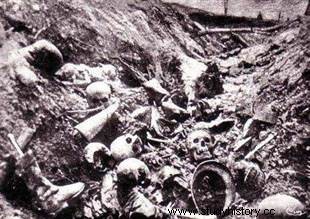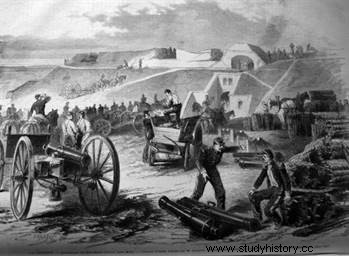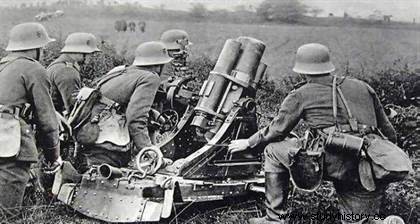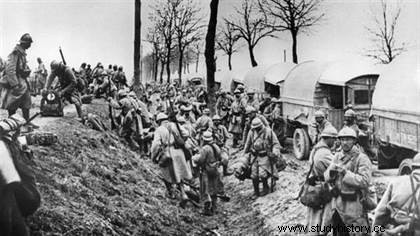 The Battle of Verdun , which opposed German troops to French troops, took place between February 21 and December 18, 1916. It began with a German offensive which aimed to "bleed white" the French army. The defense of this part of the front was quickly entrusted to General Pétain, who organized the supply of the front by creating the "sacred way", a widened and maintained road for the uninterrupted passage of two lines of trucks. The German advance will be blocked by the tenacity of the French fighters, at the cost of a dizzying number of dead and wounded. Finally won by France, the battle of Verdun is one of the most important of the First World War (1914-1918).
The Battle of Verdun , which opposed German troops to French troops, took place between February 21 and December 18, 1916. It began with a German offensive which aimed to "bleed white" the French army. The defense of this part of the front was quickly entrusted to General Pétain, who organized the supply of the front by creating the "sacred way", a widened and maintained road for the uninterrupted passage of two lines of trucks. The German advance will be blocked by the tenacity of the French fighters, at the cost of a dizzying number of dead and wounded. Finally won by France, the battle of Verdun is one of the most important of the First World War (1914-1918).
Why the Battle of Verdun?
Since the Battle of the Marne, the war of movement has turned into a war of position:the fighters bury themselves in trenches, fight in horrible conditions, withdrawn in the mud among the rats, surrounded by corpses that it is not always possible to evacuate, and above all, survive in fear... It's on the Verdun salient that General Erich von Falkenhayn intends, as he will write later, "to bleed the French army white" by the fire of thousands of guns, that is to say to exhaust it both morally and physically before overcome it completely. He is supported in this objective by the Kronprinz, eldest son of William II, also determined to annihilate the French army and who describes Verdun as the symbolic "heart of France".
 The Germans know the importance of this site located on the Meuse, in Lorraine, whose fortifications make it both a strategic issue and a matter of national honor for the French. The defense of Verdun has a very old military history:fortifications already existed in the 14th century, before an underground citadel was built under Louis XIII, consolidated under Louis XIV with Vauban, then further reinforced at the end of the 19th century. Twice the city was besieged and taken by the Prussians, in 1792 and in 1870.
The Germans know the importance of this site located on the Meuse, in Lorraine, whose fortifications make it both a strategic issue and a matter of national honor for the French. The defense of Verdun has a very old military history:fortifications already existed in the 14th century, before an underground citadel was built under Louis XIII, consolidated under Louis XIV with Vauban, then further reinforced at the end of the 19th century. Twice the city was besieged and taken by the Prussians, in 1792 and in 1870.
Verdun is indeed difficult to defend because the Meuse cuts the battlefield in two, while the front has a salient, so two parts to defend instead of just one. The Germans also know that it is difficult for the French to come to the aid of the troops based in Verdun, due to the absence of a railway line worthy of the name.
Furthermore, the forts lack manpower and sufficient armament, since Joffre is convinced of the almost impregnable character of the Verdun fortifications and does not even imagine an offensive there. Moreover, in August 1915, the military authorities decided to move around forty heavy batteries and around ten field batteries to other sectors deemed to be more sensitive. Also, when the Battle of Verdun broke out, the French were particularly surprised, expecting a battle in Champagne.
A carefully prepared offensive
Decided on in December 1915, the Battle of Verdun, which the German high command wanted to be decisive, was meticulously prepared. Concrete tunnels were laid as close as possible to the French positions, deep dugouts were dug to accommodate 72 assault battalions, and German manpower was increased to eight divisions. The German army is placed on a front of a dozen kilometers and 221 artillery batteries are installed. Despite the secrecy surrounding these preparations, the French intelligence services are informed of an attack planned for February 11. But the military authorities give little credit to this surprising information, even if some reinforcements are sent on the spot, in case... For meteorological reasons, the attack is postponed for a few days.
 On February 21, at 7:30 a.m., German artillery went into action. It holds more than 1.2 million guns, including 13 formidable 420 mm Krupps. The three French divisions present on this front of only fifteen kilometers are attacked by a deluge of bombs. Von Falkenhayn thus hoped to annihilate as much as possible the opposing infantry, which only had 65 artillery batteries and 270 guns to retaliate. At the end of the afternoon, after nine hours of bombing, the German artillery gave way to the infantry:the German infantry launched themselves against the French positions, and, for the first time, the formidable weapon that was the flamethrower is used.
On February 21, at 7:30 a.m., German artillery went into action. It holds more than 1.2 million guns, including 13 formidable 420 mm Krupps. The three French divisions present on this front of only fifteen kilometers are attacked by a deluge of bombs. Von Falkenhayn thus hoped to annihilate as much as possible the opposing infantry, which only had 65 artillery batteries and 270 guns to retaliate. At the end of the afternoon, after nine hours of bombing, the German artillery gave way to the infantry:the German infantry launched themselves against the French positions, and, for the first time, the formidable weapon that was the flamethrower is used.
In a few days, while two million shells were dropped on the French positions in the first 48 hours, the French front was sunk up to ten kilometers. However, while their artillery fire is relentless, the Germans are surprised to see the French soldiers, even isolated and without command, persist in defending their positions. Although the French deplore the loss of 20,000 men and the fort of Douaumont fell on February 25, Joffre gives the order to resist at all costs, asserting with determination:“They will not pass! ". He entrusted command of the defense of Verdun to General Philippe Pétain, at the head of the 2nd Army and assisted by Generals Nivelle and Mangin.
Pétain organizes the defense
In place from February 26, Pétain intended to seal the breach made by the enemy and organized a liaison with the rear:6,000 trucks took the only road leading from Bar-le-Duc in Verdun, the "sacred way", thus allowing in the space of 24 hours to transport reinforcements, supplies of food and ammunition. On their return, they repatriate the many wounded. Now, 90,000 people and 50,000 tonnes of material are transported each week. In addition, to limit losses in each of the divisions and allow the soldiers to rest in the vicinity of Bar-le-Duc, Pétain set up a rotation of units, which will bring two-thirds of the French army to participate. in the battles of Verdun.
 From February to April, the strength of the French armies increased from 230,000 to 584,000 men, while the artillery is approaching 2,000 guns, a quarter of which is made up of heavy weapons. However, the Germans continued to prove formidable:on February 27, Fort Douaumont, guarded by only about sixty soldiers, was taken. On March 6, the Germans attacked on the left bank of the Meuse, taking the Bois de Cumières on March 7, the Mort-Homme ridge on March 14, and Hill 304 on May 24.
From February to April, the strength of the French armies increased from 230,000 to 584,000 men, while the artillery is approaching 2,000 guns, a quarter of which is made up of heavy weapons. However, the Germans continued to prove formidable:on February 27, Fort Douaumont, guarded by only about sixty soldiers, was taken. On March 6, the Germans attacked on the left bank of the Meuse, taking the Bois de Cumières on March 7, the Mort-Homme ridge on March 14, and Hill 304 on May 24.
At the beginning of spring, the German assault on the eastern and western fronts managed to be repulsed, just as the breach made by the enemy was filled in at the end of March. Although the armies of the Kronprinz had been defeated on April 9, the Germans managed to recover quickly and General Mangin failed to reconquer Douaumont from May 22 to 24. Despite the importance of the losses suffered in "the hell of Verdun", the war of attrition continues. On June 7, the fort of Vaux was taken by the Germans, who launched a new assault at the end of June on Thiaumont, Fleury and around Froi-deterre.
The terrible phosgene bombs appear for the first time and the Germans manage to advance 3 kilometers, which threatens the French positions at the level of the right bank of the Meuse. But the situation on the Somme, further north, gradually swung the balance of power:on July 1, the Franco-British forces launched a vast offensive there which forced the Germans to reduce their troops in Verdun to hold their positions in the Somme.
The Battle of Verdun turns to the advantage of the French
 In Verdun, the Kronprinz attempted a new assault on Fort Souville on July 11, but the response of the French artillery and counter-attacks save the situation in extremis. Given the difficulties encountered by the German forces, General von Falkenhayn was relieved of his duties on August 29, 1916, which were entrusted to Marshal Hindenburg, assisted once again by General Ludendorff.
In Verdun, the Kronprinz attempted a new assault on Fort Souville on July 11, but the response of the French artillery and counter-attacks save the situation in extremis. Given the difficulties encountered by the German forces, General von Falkenhayn was relieved of his duties on August 29, 1916, which were entrusted to Marshal Hindenburg, assisted once again by General Ludendorff.
On October 24, General Robert Nivelle, who succeeded General Pétain as head of the 2nd Army (Pétain was given command of the Army Group Center) , launched a counter-offensive on Verdun. This made it possible to definitively reverse the situation by regaining the ground constantly lost since February:the fort of Douaumont was recaptured in a few hours, then that of Vaux on November 2, finally making the Germans retreat. The front stabilized along a Champneuville-Bezonvaux line, on the right bank of the Meuse.
On December 18, 1916, the Battle of Verdun was won by the French.
Verdun's "butcher's shop"
After ten months of massacres and 37 million shells fired, this victory has an immense psychological impact. France retains the advantage over the Verdun region despite the heavy price paid:nearly 380,000 killed, missing and injured. Germany suffered a double defeat:on the one hand, it did not succeed in its breakthrough from the French front and, on the other hand, its human losses (estimated at 335,000 killed, missing and wounded) were almost as great as those of France. Verdun is the deadliest battle of the First World War, after that of the Somme.
Bibliography
- The Battle of Verdun by Claude Carlier. Economica, 1997.
- Verdun - the greatest battle in history told by the survivors of Jacques-Henri Lefebvre. 2008.
To go further
- The Verdun Memorial.
- Wars And Great Battles /Vol.3:The Battle Of Verdun (1916). Documentary, DVD, 2009.
